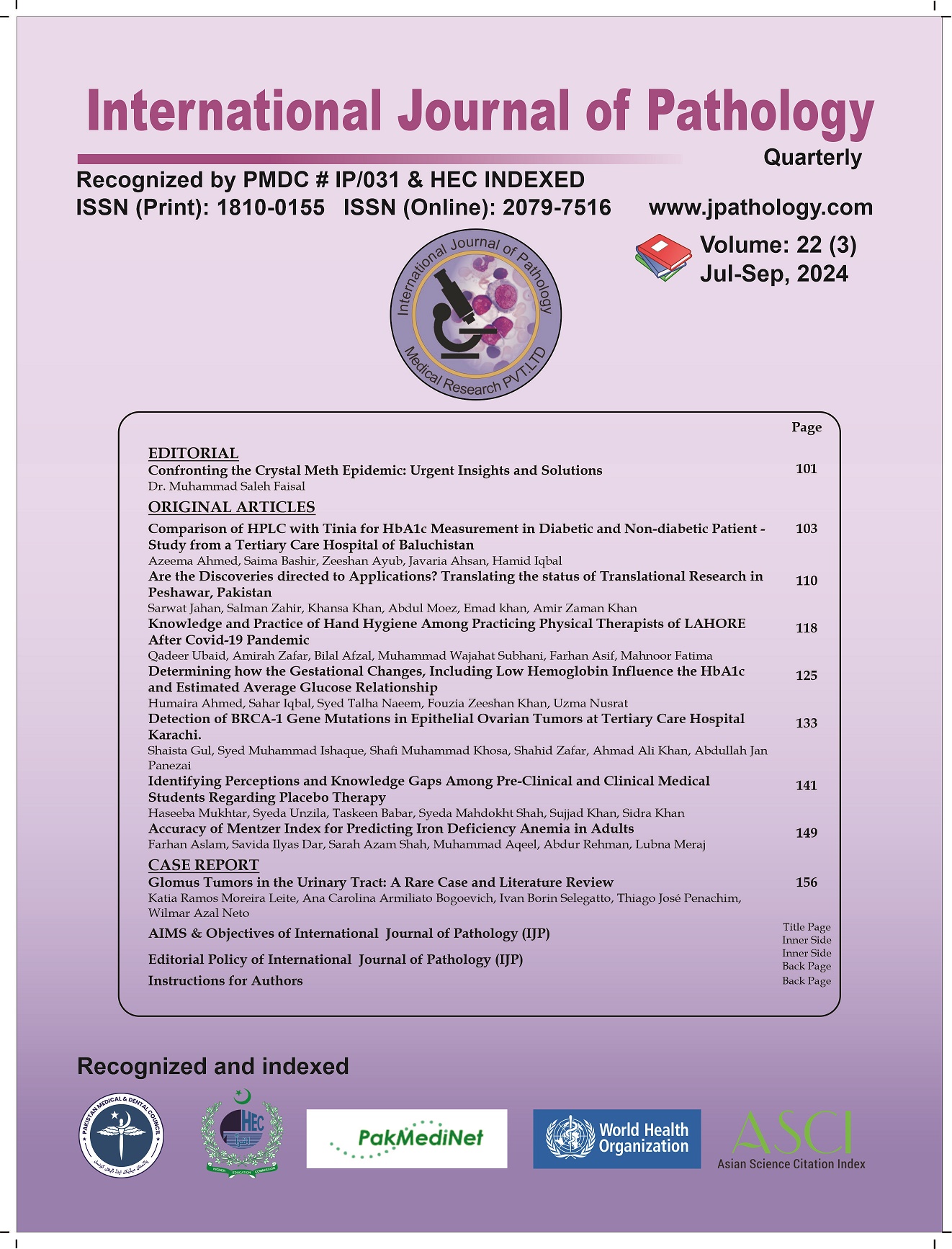Detection of BRCA-1 gene mutations in epithelial ovarian tumors at tertiary care hospital Karachi
DOI:
https://doi.org/10.59736/IJP.22.03.917Keywords:
Benign, BRCA-1, Cyst Adenocarcinoma Malignant, Mucious, Polymerase Chain Reaction (PCR), TumorAbstract
ABSTRACT
Background: Ovarian cancer is the most common and lethal gynecological malignancy. Ovarian malignancy is the 3rd most common cancer in Pakistan. More than 90% ovarian cancers are of epithelial cell origin, about 24-40% such cancers have hereditary or sporadic mutation in the BRCA-1 or BRCA-2 genes. The present study was designed to detect BRCA-1 gene mutations in different histological sub-types of epithelial origin of benign, borderline and malignant ovarian tumors.
Methods: This cross-sectional study was based on the analysis of BRCA-1 gene mutations in the epithelial origin of benign, borderline and malignant ovarian tumors received at the department of Pathology, Basic Medical Sciences Institute, Jinnah Post graduate Medical Centre, from 01-01-2011 to 31-12-2015. A total of 80 diagnosed cases were selected and analyzed for PCR.
Results: BRCA-1 gene mutations were detected in 22 (27.5%) cases out of the 80 randomly selected epithelial ovarian tumors. Serous cyst adenocarcinoma was the commonest including 63% cases. BRCA-1 gene mutations were also positive in other epithelial ovarian tumors, including Mucinous cyst adenocarcinoma (13.6%), Endometroid adenocarcinoma and Mixed Mullerian tumor (4.5% each). In addition mutations were also detected in borderline tumors including Mucinous borderline tumor (9.09%) and Seromucinous borderline tumors (4.5%).The observations and results of the study were elaborated with the assistance of tables, figures and photomicrographs.
Conclusion: BRCA-1 gene mutations manifestations were identified in a large number of serous malignant ovarian tumor cases. Small percentages of borderline and malignant mucinous tumors, endometroid adenocarcinoma and mixed mullerian tumor were also positive for BRCA-1 gene mutations.
References
Kumar V, Abbas AK and Aster JC- Robbins and Cortan. Pathologic basis of diseases. The Female genital tract, Ovaries. Elsevier, South Asian (9th) Ed. 2014; (2): 1022-34.
Fletcher CDM. Diagnostic histopathology of tumor. Tumors of the Female genital tract, Ovary. Elsevier china 4th Ed. 2013; (2): 658-730.
Rosai J, Ackerman. Surgical pathology. Female reproductive system, Ovary. Elsevier New Delhi India. 10th Ed. 2011; (2): 1170-1259.
Permuth-Wey J, Besharat A, Sellers TA. Epidemiology of ovarian cancer: an update. Advances in diagnosis and management of ovarian cancer 2013 Oct 22 (pp. 1-21).
Lisio, M.-A.; Fu, L.; Goyeneche, A.; Gao, Z.-h.; Telleria, C. High-Grade Serous Ovarian Cancer: Basic Sciences, Clinical and Therapeutic Standpoints. Int. J. Mol. Sci. 2019, 20, 952. https://doi.org/10.3390/ijms20040952
Danish F, Khanzada MS, Mirza T, Aziz S, Naz E , Khan MN. Histomorphological spectrum of ovarian tumors with immunohistochemical analysis of poorly or undifferentiated malignancies. Gomal J Med Sci 2012; 10 (2): 209-15.
Boyd J, Sonoda Y, Federici MG, Bogomolniy F, Rhei E, Maresco DL et al. Clinicopathologic features of BRCA-linked and sporadic ovarian cancer. JAMA 2000; 283 (17): 2260-65.
Sun C, Li N, Ding D, Weng D, Meng L, Chen G, et al. The role of BRCA status on the prognosis of patients with epithelial ovarian cancer: a systematic review of the literature with a meta-analysis. PloS one. 2014 May 1; 9(5):e95285.
Orwell G. Cancer Genetics In: Embery s Elements of Medical Genetics, 14th Ed, Elsevier, Churchill Livingstone, 2012; 214-18.
Grazybowska E, Sieminska M, Zientek H, Kalinowska E, Michalska J, Hutka B et al. Germline mutations in the BRCA-1 gene predisposing to breast and ovarian cancers in Upper Silesia population. Acta Biochimica Polonica 2002; 49 (2): 351-56.
Meisel LJ, Hyman DM, Garg G, Zhou Q, Dao F, Bisogna M et al. The performance of BRCA-1 immunohistochemistry for detecting germline, somatic, and epigenetic BRCA-1 loss in high-grade serous ovarian cancer. Ann Oncol (2014) 25 (12): 2372-78.
Kurman RJ and Shih I. Molecular pathogenesis and extra ovarian origin of epithelial ovarian cancers. Hum Pathol 2011; 42 (7): 918-31.
Girolimetti G, Perrone AM, Santini D, Barbieri E, Guerra F, Ferrari S et al. BRCA-Associated ovarian cancer: From Molecular genetics to risk management. Bio Med Res Intern 2014; 2014(1):787143.
Vaidyanathan K, Lakhotia S, Ravishankar HM, Tabassum U, Mukherjee G, Somasundaram K. BRCA-1 and BRCA-2 germline mutation analysis, among Indian women from south India: identification of four novel mutations and high-frequency occurrence of 185delAG mutation. J Bio sci. 2009 Sep; 34 (3): 415-22.
Geisler JP, Hatterman-Zogg MA, Rathe JA and Buller RE. Frequency of BRCA-1 dysfunction in ovarian cancer. J Nat Cancer Inst 2002; 94 (1): 61-67.
Ellison G, Huang S, Carr H and Wallace A. A reliable method for the detection of BRCA-1 and BRCA-2 mutations in formalin fixed tumor tissue utilizing multiplex PCR-based targeted next generation sequencing. BMC Clin Pathol 2015; 15:1-4.
Mafficini A, Simbolo M, Parisi A, Rusev B, Luchini C, Cataldo I et al. BRCA somatic and germline mutation detection in paraffin embedded ovarian cancers by next-generation sequencing. Oncotarget. 2016 Jan 1; 7(2):1076.
Bjorge T, Lie AK, Hovig E, Gislefoss RE, Hansen S, Jellum E et al. BRCA-1 mutations in ovarian cancer and borderline tumors in Norway: a nested case control study. Br J Cancer 2004 Nov;91(10):1829-34.
Candido-dos-reis FJ, Song H, Goode EL, Cunningham JM and Fridley BL. Germline Mutation in BRCA-1 or BRCA-2 and Ten-Year Survival for Women Diagnosed with Epithelial Ovarian Cancer. Clin Cancer Res. 2015 Feb 1; 21 (3): 652-57. https://doi.org/10.1158/1078-0432.CCR-14-2497
Pal T, Permuth-Wey J, Betts JA, Krischer JP, Fiorica J, Arango H et al. BRCA-1 and BRCA-2 mutations account for a large proportion of ovarian carcinoma cases. Cancer 2005 Dec 15; 104(12):2807-16. Doi: 10.1002/cncr.21536.
Downloads
Published
Issue
Section
License
Copyright (c) 2024 Shaista Gul, Syed Muhammad Ishaque, Shafi Muhmmad Khosa, Shahid Zafar, Ahmad Ali Khan, Abdullah Jan Panezai

This work is licensed under a Creative Commons Attribution-NonCommercial 4.0 International License.
Readers may “Share-copy and redistribute the material in any medium or format” and “Adapt-remix, transform, and build upon the material”. The readers must give appropriate credit to the source of the material and indicate if changes were made to the material. Readers may not use the material for commercial purpose. The readers may not apply legal terms or technological measures that legally restrict others from doing anything the license permits.


